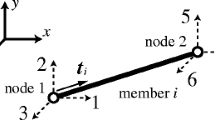Abstract
A set of recursive equations are introduced for optimum design of a wide range of hierarchical truss beams to satisfy a minimum required natural frequency. The design equations are based on a general analytical solution, which are derived based on a critical dimensional analysis. A practical example is examined in both 2D and 3D spaces, which promises substantial mass reduction, as much as 99%, when using high order hierarchical truss beams. The results are verified by numerical evaluation of three case studies. The approach looks also very promising to design nanostructures when it comes to the problems associated with vibration.
Similar content being viewed by others
References
R. Lakes, Materials with structural hierarchy, Nature, 361 (1993) 511–515.
J. D. Murphey and T. W. Hinkle, Some performance trends in hierarchical truss structures. In Proc. 44th Structures, Structural Dynamics and Materials Conf. AIAA/ASME/ASCE/AMS/ASC., Norfolk, VA, (2003) AIAA-2003-1903.
D. Waller, Mechanics of novel compression structures. Phd thesis, University of Cambridge, (2006).
B. Mandelbrot, The fractal geometry of nature, W.H. Freeman, N.Y., (1983).
E. Baer, A. Hiltner and H. Keith, Hierarchical structure in polymeric materials, Science, 235 (1987) 1015–1022.
H. Loyrette, Gustave eiffel, Rizolli, N.Y., (1985).
A. Salehian, E. M. Cliff and D. J. Inman, Continuum modeling of an innovative space-based radar antenna truss, J. Aerosp. Engrg., 19(4) (2006) 227–240.
A. Meguro, S. Harada and M. Watanabe, Key technologies for high-accuracy large mesh antenna reflectors, Acta Astronautica, 53 (2003) 899–908.
F. Dyson, The search for extraterrestrial technology, In au]R. Marshak, editor, Perspectives in modern physics, Interscience Publishers (1966) 641–655.
J. Parkinson, Structures analysed anew, New Civil Engineer, 21, (1982).
J. Parkinson, Tubes vs truss: Winners revealed, New Civil Engineer, 18–19, (1982).
J. Parkhouse, Structuring: A process of material dilution. In au]N. Nooshin, editor, Third international conference on space structures, Guildford, UK: Elsevier Applied Science, London (1984) 367–374.
Anonymous, Hierarchical structures in biology as a guide for new materials technology, National Academy Press, Washington, D.C., (1994).
A. Carpinteri, N. Pugno and A. Sapora, Asymptotic analysis of a von Koch beam, Chaos, Solitons and Fractals, 41 (2009) 795–802.
A. Carpinteri, N. Pugno and A. Sapora, Free vibration analysis of a von Koch beam, International Journal of Solids and Structures, 47 (2010) 1555–1562.
M. M. Mikulas, Structural efficiency of long lightly loaded truss and isogrid columns for space applications, Technical Report TM-78687, NASA, (1978).
C. T. Sun and S. W. Liebbe, Global-local approach to solving large truss structures, AIAA Journal, 28(2) (1990) 303–308.
A. Salehian and D. J. Inman, Dynamic analysis of a lattice structure by homogenization: Experimental validation, Journal of Sound and Vibration, 316 (2008) 180–197, doi:10.1016/j.jsv.2008.02.031.
M. S. Lake and E. C. Klang, Generation and comparison of globally isotropic space-filling truss structures, AIAA Journal, 30(5) (1992).
W. T. Thomson, Theory of vibration with applications, Prentice-Hall, 5th edition, (1998).
M. Arndt, R. D. Machado and A. Scremin, An adaptive generalized finite element method applied to free vibration analysis of straight bars and trusses, Journal of Sound and Vibration, 329 (2010) 659–672.
Author information
Authors and Affiliations
Corresponding author
Additional information
This paper was recommended for publication in revised form by Editor Yeon June Kang
Seyed M. Malaek is a professor at Sharif University of Technology in Tehran, Iran. His research interests include airplane design, flight performance optimization, and air traffic management. He is the author of two books in flight dynamics and modeling techniques and over 60 papers in the areas indicated. He has one patent on rotary cockpit for single seat aircraft. Dr. Malaek obtained his M.S. degree in 1986 and his Ph.D in 1990 from the University of Kansas, U.S.A.
Ali Abedian is an associate professor of aerospace engineering at Sharif University of Technology (SUT), Tehran, Iran. He is working in the areas of composite materials and aging of metallic and composite structures.
Norodin Fazli was born in Gonbad Kavoos city, in the north of Iran, in May of 1978. He received his B.Sc. and M.Sc. degrees in Aerospace Engineering from SUT in 2000 and 2002, respectively, and currently is a Ph.D student. His research interests are in the development of design strategies for special structures (i.e., tensegrity structures, mesh antennas and fractal structures).
Hessamodin Teimouri received his B.Sc. and M.Sc. degrees in Aerospace Engineering from SUT. His fields of interest are structural health monitoring, continuum damage mechanics, micromechanics of composites, FEM.
Rights and permissions
About this article
Cite this article
Fazli, N., Malaek, S.M.B., Abedian, A. et al. Development of a new analytical tool to design hierarchical truss beams for natural frequency. J Mech Sci Technol 25, 2495–2503 (2011). https://doi.org/10.1007/s12206-011-0733-0
Received:
Revised:
Accepted:
Published:
Issue Date:
DOI: https://doi.org/10.1007/s12206-011-0733-0




